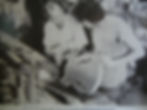The Art of Luthiery

The Roberto-Venn School of Luthiery, located on Grand Avenue, is approaching its 40th year of training guitar luthiers, making the school the longest running of its kind in North America.
The term luthier—someone who makes and repairs stringed instruments—originates from the French word ‘luth’, which means lute, explained William Eaton, director and one of the founders of the Roberto-Venn School. The craft of luthiery is usually divided between makers of string instruments that are plucked, like a guitar, or bowed instruments, like a violin.
“The stringed instrument family does have some basic principles of how they create sound through the vibration of a string and transferring that string energy into a cavity that produces sounds,” Eaton said. “We’ve chosen to focus on guitars. Our students come to learn building and repairing guitars.”
Eaton, while pursuing a master’s degree at Stanford University, created a business plan for a guitar school, which he sent to John Roberts and Bob Venn who at the time were running Juan Roberto Guitar Works, an informal guitar workshop in Arizona.
“Both of them said yes,” Eaton said. “I didn’t put my name on the business, but the three of us were the founders. And that was the start of the Roberto-Venn School in 1975.”
Since then, the school has graduated over 2,000 luthiers, with students enrolling from across the globe.
“Students have come from every continent except Antarctica,” Eaton said. “We shoot for a class size of 35 to 40. That’s our target based on the number of workbenches and instructors.”
In order to graduate students must complete a five-month course—880 clock hours—in which they simultaneously build an acoustic and electric guitar. Currently, 41 students are enrolled in the program under the instruction of eight teachers.
“The instructors have different roles,” Eaton said. “It’s the most talented group we’ve ever had. Everyone of them could make a living as a guitar maker so we feel very privileged that they’ve decided to stay on and teach.”
Josiah Upshaw, an instructor and a 2009 graduate of the school, said that his start in luthiery came from a direct interest in building guitars, but that his students have assorted backgrounds.
“It really depends,” Upshaw said. “You get a lot of guys who’ve played guitar all their lives, then you get some guys who like the woodworking aspect of it but have never picked up a guitar. They’re learning about the instrument as they’re building it. It’s a good mix of a lot of different backgrounds.”
From various entries into the field of luthiery come various styles, which Eaton said contributes to the uniqueness of a handcrafted instrument. What with the extension of knowledge in guitar-making and rapid technological advancements, mass-produced guitars are better than they have ever been; however, according to Eaton, where a luthier competes in today’s guitar industry is with the element of customization.
“A handcrafted instrument certainly has a character that’s tangible,” Eaton said. “When it comes from one builder, you get a whole different sensibility in seeing, playing, feeling and listening to that instrument, than one that’s made in a factory situation.”

While Eaton would not stereotype that a custom instrument is better than one that is factory-made, he said differences could be noted. A handcrafted guitar is often commissioned by someone looking for attention in detail in the finish work, a particular feel in a fret-board, or even with a specific type of wood in mind.
“From ash to alder, maple to sycamore, each wood has its own certain sound flavor,” said John Reuter, director of training and instructor at the Roberto-Venn School. “It’s like walking into Basking Robins and asking what’s the difference between all the flavors. Each wood has its own certain sound and there’s no right or wrong.”
Traditionally, guitar-making has called for Brazilian rosewood, spruce tops, and ebony fret boards, but with the expansion of luthiery and for reasons such as scarcity and restrictions on exporting wood from South America, the list of usable wood has grown, said Reuter.

The Roberto-Venn School offers a variety of wood for its students to work with, as various suppliers contact the school weekly, and Eaton mentioned that a fair amount of mahogany is still procured in Phoenix.
“Air-dried wood is usually what’s required,” Eaton said. “From seed to tree to becoming a guitar, the wood is full of cellular structure that can expel or absorb moisture, meaning it’s moving. The degree that the wood moves is what repair technicians deal with. The desert has turned out to be a pretty good place for us.”







